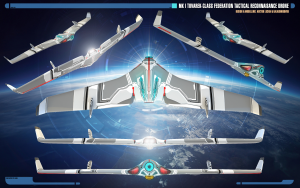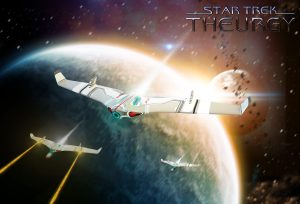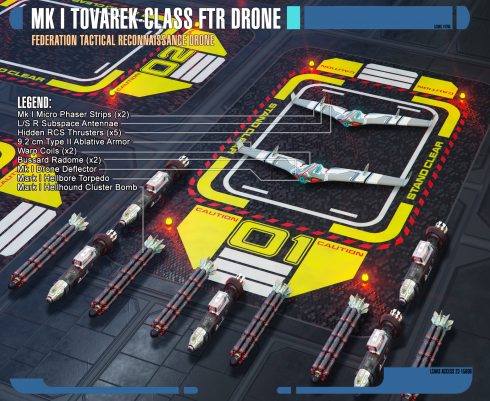Mk I Tovarek-class FTR Drone: Difference between revisions
From Star Trek: Theurgy Wiki
Auctor Lucan (talk | contribs) |
m (Added OGS Subtype to Page) |
||
| Line 107: | Line 107: | ||
==== Mk I Hellhound Cluster Bomb ==== | ==== Mk I Hellhound Cluster Bomb ==== | ||
[[File:hell-hound-details.png|left|150px]]Similar in nature to the photon torpedo, this was a photon torpedo filled with several micro torpedoes. Once the torpedo came in contact with an enemy or a surface, it detonated and fragmented into smaller torpedoes, which spread from the point of impact, also exploding on impact, resulting in a large pattern of torpedo detonations. Deployed correctly, this hard-point had the potential to cause severe damage when scattered upon enemy shields on impact. The torpedo snapped open by spring-force, and both the arming and the fuse was pilot-controlled by either manual or automatic settings. It could be armed prior to discharge or scattered by manual command. | [[File:hell-hound-details.png|left|150px]]Similar in nature to the photon torpedo, this was a photon torpedo filled with several micro torpedoes. Once the torpedo came in contact with an enemy or a surface, it detonated and fragmented into smaller torpedoes, which spread from the point of impact, also exploding on impact, resulting in a large pattern of torpedo detonations. Deployed correctly, this hard-point had the potential to cause severe damage when scattered upon enemy shields on impact. The torpedo snapped open by spring-force, and both the arming and the fuse was pilot-controlled by either manual or automatic settings. It could be armed prior to discharge or scattered by manual command. | ||
== Mk II Tovarek-class OGS Subtype == | |||
Between the Battle of Starbase-84, and subsequently the Battle of the Apertures, all but one of the Mk I Tovarek-class drones aboard Theurgy had been destroyed, save only one that had been so badly damaged so as to miss the second engagement. For weeks it sat un-attended in the upper shuttle-bay collecting dust, until a requisition order was later put in by the Intelligence Department for it to be renovated with a new mission in mind. | |||
Drawing upon inspiration from 21st-century un-manned aerial drones that would loiter in airspace as ground operations unfolded below, the new Mk II Tovarek-class drones was intended to specialize in a purely ground support role. The already innate ability of the Tovarek to emit false sensor readings, once further tweaked, would then allow this new subtype to loiter in orbit of a planet in a mostly undetected fashion. From there, it was to provide overwatch of missions, as well as a host of other functions. | |||
As such, it was given a new designation as an Overwatch & Ground Support (OGS) Drone. | |||
== Detailed View == | == Detailed View == | ||
Revision as of 23:41, 15 July 2020

| |
| Name: | Mk I Tovarek-class FTR Drone |
| Model: | UAV Warp Drone |
| Production Status: | Prototype Testing Stage |
| Role: |
|
| Constructed: | Black Opal & the USS Theurgy |
| Commissioned: | March 19th, 2381 |
| Dimensions: |
|
| Standard Crew Complement: |
|
| Warp & Impulse Speeds: |
|
| Tactical Specs: |
|
| Defensive Specs: |
|
| Engine Specs: |
|
| Other Systems |
|
| Sensors |
|
| Design: | |
| 3D Model: |
Kalashnikov 3D |
These prototype Federation Tactical Reconnaissance (FTR) Drones were found on the Black Opal and their assembly was completed on the USS Theurgy. These unmanned, small crafts were remote-controlled by Thea when deployed from her Upper Shuttle Bay.
Aside from their tactical advantages as decoys and their advanced sensors, they were also fitted with wing-mounted Type IV Phaser strips. Before deployment, they could also be fitted with a torpedo tube underneath the main fuselage, thus making them able to deal a singular, heavy blow against unsuspecting targets. Another advantage was also how they could emit false sensor readings, making them ideal as decoys or making an enemy think they are up against a full-sized warp fighter.
Drone Demonstration
Production History
When these were found on the Black Opal in March of the year 2381, they were not fully assembled yet. Morwen Angharad, the base's Science Officer, had volunteered to a testing program. The conceptual plans were made by the Advanced Starship Design Bureau and the prototype parts had been shipped to the Black Opal for final assembly. Yet Angharad had only volunteered to the program out of the sheer boredom of her posting on the Black Opal, so she never finished the assembly. She did not have the required skills to do so, since she was more of a scientist than an engineer. Hence, the drones were abandoned for sake of more compelling activities. This was, of course, until the Theurgy arrived at the Black Opal.
Under the supervision of Simon Tovarek, ablative hull and advanced tactical sensors were added to the drones. The original plans had not included the tactical abilities that Tovarek gave it, so after Angharad didn't want to take credit for her intial work, it was decided that the drones would be named after Tovarek. Ten more drones were completed in time for the mission to Starbase 84, resulting in a complement of thirty Mk I Tovarek-class drones aboard the USS Theurgy by the time of the arrival to the base, and the mission to spread the truth about Starfleet Command.
External Hard-point Options
Aside from the phaser strips, which can provide forward, aft, dorsal and ventral firing, the drones can use one hard-point option during missions, as listed below.
Mk I Hellbore Torpedo
An experimental weapon that grew out of historic tandem-charge armour-penetrating designs. Attempting to achieve similar function from contemporary photon and quantum warheads was pointless; the detonation of the first would obliterate the second too early, and a submunition method was less effective than simply firing two torpedoes. Advances in material science led to a way to produce neutronium in small quantities - fashioned into a penetrator cap and coupled to a small subspace field generator, and driven by a single-burn impulse unit whose size belied its power, the nose of the missile could tear its way through alloys with even the strongest of structural integrity field enhancements, allowing the oversized antimatter warhead in the belly of the torpedo to detonate well inside the defensive screens of its target. Due to the projectile's large size and slower speed compared to the smaller conventional torpedoes, it was ineffective against shielded targets and had to be deployed against unprotected hulls to be useful.
Mk I Hellhound Cluster Bomb
Similar in nature to the photon torpedo, this was a photon torpedo filled with several micro torpedoes. Once the torpedo came in contact with an enemy or a surface, it detonated and fragmented into smaller torpedoes, which spread from the point of impact, also exploding on impact, resulting in a large pattern of torpedo detonations. Deployed correctly, this hard-point had the potential to cause severe damage when scattered upon enemy shields on impact. The torpedo snapped open by spring-force, and both the arming and the fuse was pilot-controlled by either manual or automatic settings. It could be armed prior to discharge or scattered by manual command.
Mk II Tovarek-class OGS Subtype
Between the Battle of Starbase-84, and subsequently the Battle of the Apertures, all but one of the Mk I Tovarek-class drones aboard Theurgy had been destroyed, save only one that had been so badly damaged so as to miss the second engagement. For weeks it sat un-attended in the upper shuttle-bay collecting dust, until a requisition order was later put in by the Intelligence Department for it to be renovated with a new mission in mind.
Drawing upon inspiration from 21st-century un-manned aerial drones that would loiter in airspace as ground operations unfolded below, the new Mk II Tovarek-class drones was intended to specialize in a purely ground support role. The already innate ability of the Tovarek to emit false sensor readings, once further tweaked, would then allow this new subtype to loiter in orbit of a planet in a mostly undetected fashion. From there, it was to provide overwatch of missions, as well as a host of other functions.
As such, it was given a new designation as an Overwatch & Ground Support (OGS) Drone.




